FGCaMP7, an Improved Version of Fungi-Based Ratiometric Calcium Indicator for In Vivo Visualization of Neuronal Activity
- PMID: 32344594
- PMCID: PMC7215472
- DOI: 10.3390/ijms21083012
FGCaMP7, an Improved Version of Fungi-Based Ratiometric Calcium Indicator for In Vivo Visualization of Neuronal Activity
Abstract
Genetically encoded calcium indicators (GECIs) have become a widespread tool for the visualization of neuronal activity. As compared to popular GCaMP GECIs, the FGCaMP indicator benefits from calmodulin and M13-peptide from the fungi Aspergillus niger and Aspergillus fumigatus, which prevent its interaction with the intracellular environment. However, FGCaMP exhibits a two-phase fluorescence behavior with the variation of calcium ion concentration, has moderate sensitivity in neurons (as compared to the GCaMP6s indicator), and has not been fully characterized in vitro and in vivo. To address these limitations, we developed an enhanced version of FGCaMP, called FGCaMP7. FGCaMP7 preserves the ratiometric phenotype of FGCaMP, with a 3.1-fold larger ratiometric dynamic range in vitro. FGCaMP7 demonstrates 2.7- and 8.7-fold greater photostability compared to mEGFP and mTagBFP2 fluorescent proteins in vitro, respectively. The ratiometric response of FGCaMP7 is 1.6- and 1.4-fold higher, compared to the intensiometric response of GCaMP6s, in non-stimulated and stimulated neuronal cultures, respectively. We reveal the inertness of FGCaMP7 to the intracellular environment of HeLa cells using its truncated version with a deleted M13-like peptide; in contrast to the similarly truncated variant of GCaMP6s. We characterize the crystal structure of the parental FGCaMP indicator. Finally, we test the in vivo performance of FGCaMP7 in mouse brain using a two-photon microscope and an NVista miniscope; and in zebrafish using two-color ratiometric confocal imaging.
Keywords: FGCaMP; FGCaMP7; calcium imaging; crystal structure; genetically encoded calcium indicator; protein engineering.
Conflict of interest statement
The authors declare no conflict of interest. The funders had no role in the design of the study; in the collection, analyses, or interpretation of data; in the writing of the manuscript, or in the decision to publish the results.
Figures
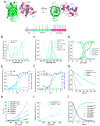

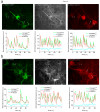
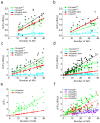


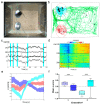
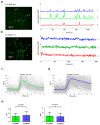

References
MeSH terms
Substances
Grants and funding
- №1360 of 25.06.2019/internal grant of the National Research Center Kurchatov Institute
- 16-15-10323/Russian Science Foundation
- 19-04-00395/Russian Foundation for Basic Research
- 17-00-00215/Russian Foundation for Basic Research
- 20-015-00427/Russian Foundation for Basic Research
- 19-315-80020/Russian Foundation for Basic Research
- 18-34-00640/Russian Foundation for Basic Research
- 17-29-07083/Russian Foundation for Basic Research
- to K.M.B./Ministry of Science and Higher Education of the Russian Federation
- 19-34-70004/Russian Foundation for Basic Research
- 075-15-2019-1669/the Ministry of Science and Higher Education of the Russian Federation
- EXC 2145 SyNergy - ID 390857198/Deutsche Forschungsgemeinschaft
LinkOut - more resources
Full Text Sources
Other Literature Sources
Molecular Biology Databases
Research Materials

